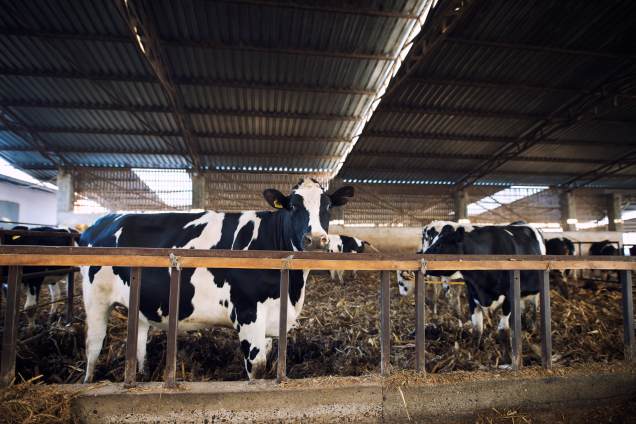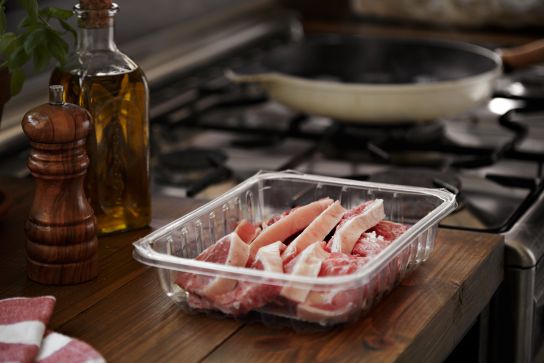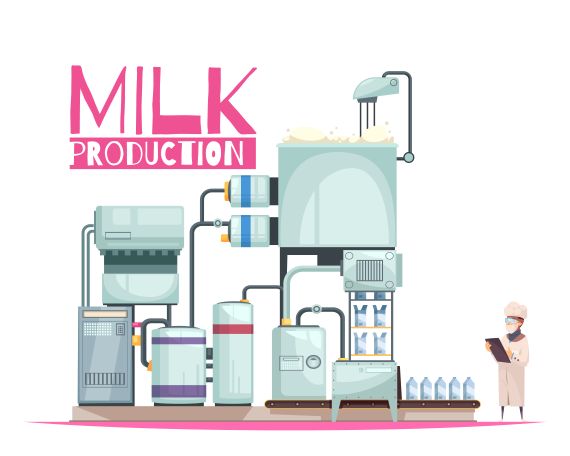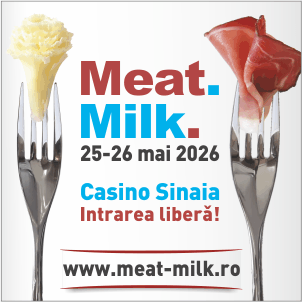
„We must understand the following issue: we have threebucketsofmilk – one ishalf full, anotheris aquarter full, andthe thirdaquarter full again. Togofurtherand more comfortably,you put the entiremilkinonebucket. Therefore, when youhave three production capacities, it is natural to move the productioninone capacity, to reduce costs, tobe ableto continue to be competitiveon the market.” (Dorin Cojocaru, president of APRIL) Commercial rules, associatedto the (non)self confidence The milk market. A competitive area where bargaining(?) has always been done „at the bayonet”, and this because, in time, there always existed the danger of a real monopoly, implemented by the major manufacturers. The European Union exposed its muscles by imposing limitations on the output, from a realm or another, but the career of the „milk quota” will end as of March 1, 2015. How much will the train timetable be affected on this route? Will the passengers-manufacturers be satisfied with the comfort offered or will they be crammed into the steam engine, for the coal fueling of an old Mocaniţa first generation train? Romania, a country that does not produce at least at the established level, is in such a situation from which the normality horizon seems more and more distant. The milk sector looks like a system with many small manufacturers and with an organization that squeaks from all its hinges, and direct sales seem to be attractive to more and more manufacturers. Mr. Dorin Cojocaru, president of APRIL describes the cold case of the milk we want warm: „Our country, with 1,360,000 cows, could have provided the necessary quantity for the market well above the milk quota allocated to Romania, but 80% of these cows are in the population’s households, and 60% of the milk produced in Romania is for selfconsumption, therefore does not enters the commercial or processing circuit. Under this circumstance, out of Romania’s quota of 1,200,000 tons only 75-80% is achieved, while the rest is milk imported raw material”. In the dairy industry, the basic rule of business transactions, the supply and the demand works as slowly- paced as in the other commercial segments: „In trade relations there are contracts, but nobody speaks about the precarious infrastructure, about the collection costs, about the large and wide dispersion of farms. Collection is done in a certain manner in the south, where we have large farms, and differently in the sub-mountainous area or in the northern Moldavia. There should have existed an agricultural policy, a vision, a projection ten years ago, because we will meet this quota liquidation in 2015. We musthavemoreconfidence in ourselves: we associate, butwe mustfollow and monitorthe entire route, because onceintwo years (I remind you, in 2009 the European milk crisis affected Romania too) there occursa worth mentioning event, the 2012 springis thespring that isnow. Everytwo years, starting with the feed manufacturer, farmer, processor, trader, modifications and variations occur throughout the supply chain. Therefore, we must listen to the expertsin thisfield (farmers, processors, market analysts, and I refer also to thosein the Ministry of Agriculture). The milk marketis very volatile; in December we hadavery good price forthe milk raw materia (the cows farm was profitable), but if we do notknow how to integrate this milk market mechanism, we will be annihilated by thefinished products comingfrom theEuropean Communityand the farmer will be decimatedby theraw material milk, thatcomesby tankfrom theEuropean Union countries”, emphasized the president of APRIL. It is understandable that the „no number” production granted to the Community states as of 2015 requires each country be prepared for the costs hard to digest from Hungary, Denmark or Germany, geographic areas where milk has a lower final cost, with the risk for Romania of „import subscription”. It’s true, the recession in 2009 resulted in the disappearance of one third of the milk producers. It was a pretty hectic period and almost in the same period the disappearance of milk quotas was decided. Increased from Brusselles by one percent per year, to give up to them in the end. Countries like Romania could not say much at the time when the milk quotas disappearance was negotiated; they did not have much choice, they knew for sure that in 2015 a period will start when only competitiveness and integrated projects will improve the situation at all pleasant in the dairy industry. Romania’s agency in Brusselles is still trying to obtain something for 2015. Nevertheless, there are plenty of positive scenarios, according to which the emerging markets (e.g China or India) could absorb the dairy products surplus, without such scenarios take the place of pessimism, according to which the production suddenly increased at the European level might result in a sharp prices drop. Does that mean Romania will be invaded with products from other states? „The main problem isthe production cost, bothin the farm,aswell as for processing. In Romania, thisisthe main problem. No matter how muchmilkwe wouldhave (little, much), no matterhow big or smallthe offer would be, wecannot be competitiveon theothermarkets. Be it China, Europeor the north of Africa... wehave high production costs. Here, Iremind: utilities, raw materials, allkinds ofchargesand taxes. The only goodthings Europe did, wastoallow more flexibilityto the new PNDR, to funds, namelyto applysome customizedmeasures for eachcountry”, believes Dorin Cojocaru.From Brusselles, the situation is seen in the same vein At his turn, the European Commissioner Dacian Cioloş was warning that abolition of milk quotas in the EU as of 2015, might have a negative impact in the areas where this sector is fragile. From Brusselles, the European commissioner repeatedly pointed out that also the Romanian farmers risk to lose on the milk market, with much tougher rigors, if the authorities will not take steps in the near future. Dacian Cioloş asserted at the beginning of the autumn that situations may be very diverse and the instruments available for the institutions of the European Union must meet the requirements of all. As to Romania, he believes that it is not the abolition of quotas the main problem. „Romania uses not even almost half of the milk quota allocated to it. Therefore, in Romania the direct problem is not the abolition of milk quotas. It may be an indirect problem, in that, by abolishing the milk quotas, there may exist an output to come from outside Romania and to compete the output in Romania”, added Dacian Cioloş. The Commissioner for agriculture believed that Romania needs a faster organization and restructuring process in this field, and the new common agricultural policy already offers the necessary instruments. A subprogram gives signsin this sector After so many arrows received in full by the milk industry, fragile rays are however seen in this sector from the Ministry of Agriculture, which assumes, at the autumn end, stress on a subprogram dedicated to this branch, preparing it thoroughly for the near future: 2014-2020. Governmental officials assure the people involved in the dairy industry that they will implement the integrated projects: production, processing, distribution, in all localities where milk production finds its place. Moreover, the representatives of the Ministry of Agriculture assume the perspective of those consolidated projects, be it agricultural cooperatives, farmers’ associations or individual farmers, who have small processing units, small collection centres or warehouses near the production unit. Indirectly supporting the conclusions expressed by the European commissioner Dacian Cioloş, the minister for Agriculture, Daniel Constantin, personally wishedto give assurances, onAugust 27, 2014, that the dairy farmsmightbe supported financially, in the period 2014-2020, by a special subprogram, deeming this sector as a challengefor Romania: „In 2015, milk quotas will beabolished, andthe challenge Romania has mightberightin this sector, becausethere will be avery strong competition on milk imports.Evencurrentlyvery many businesses in Transilvania import, unfortunately, milkfrom Hungary, becausethere exists notenough milktomeetthe quality. AndI think we shouldcomewitha subprogram for this sector”, statedthe minister for Agriculture, Daniel Constantin. The same also said that, for now, it has not been determined how this support will be allocated, but he mentioned that, in the autumn of this year, the schemes for 2014-2020 will be introduced, consistent with the Common Agricultural Policy: „I believe that further to the negotiations that took place at the Council level, where the European commissioner Dacian Cioloş was extremely active, we managed to obtain a few good things. We managed to obtain additional transition funds for farmers, otherwise they were going to remain at a lower level than that in other member states. We also obtained benefits on the young farmers component, farmers whom we will help to start business in the rural areas”, mentioned the minister for Agriculture. The same minister seemed sure that in 2015, the Romanian farmers will benefit from a special support, relying on the stimulation of family farms and medium-size farms. In his opinion, payments will increase by 2020, eliminating at the same time the black levers of system non-functionality. At the level of MARD (Ministry of Agriculture and Rural Development), „the focus is on milk because it is a bet we have with the other countries and which will start as of 2015, but we need to start preparations in 2014”, underlined Daniel Constantin. He also said that, in this line, thre is also a program dedicated to the mountain areas, where the state will support all integrated development projects, especially in ares that are hard to reach, but potentially rich in terms of agriculture, environment and culture. At the same time, most of the farmers are aware that the exponential shock expected in 2015 may be counter-balanced by organization and association in structures capable to provide economic balance to the entire productive chain: from the farm up to the final exploitation shackle. For these instruments to work, transparency and a thorough analysis are required, which requires the sector involvement, at regional and national level. At the same time, it is necessary to highlight the feasible ways from the technical, economic, budgetary and political point of view.





